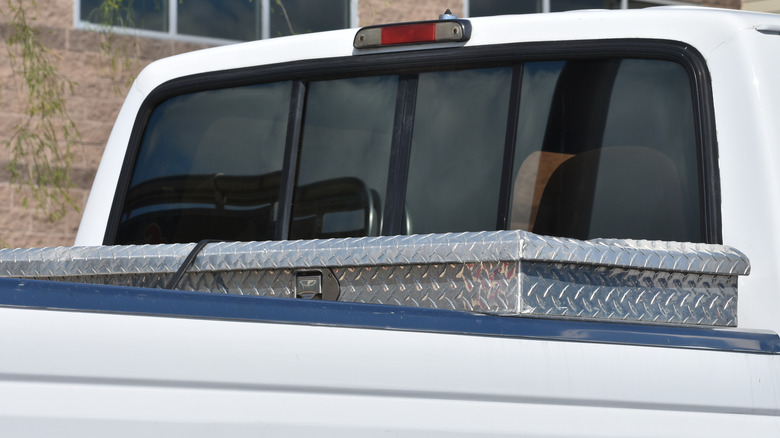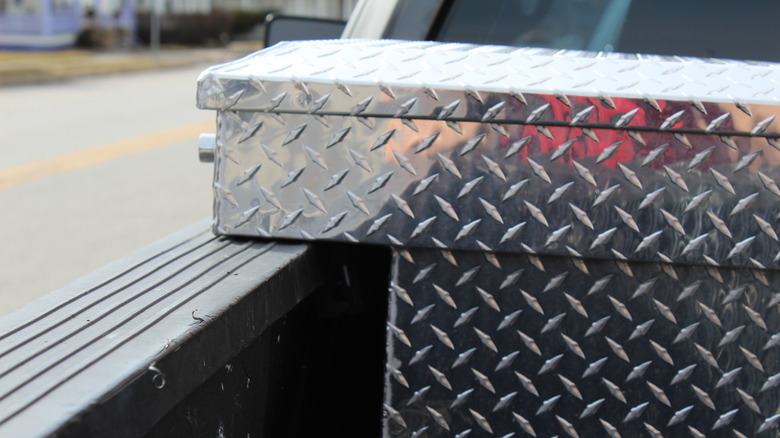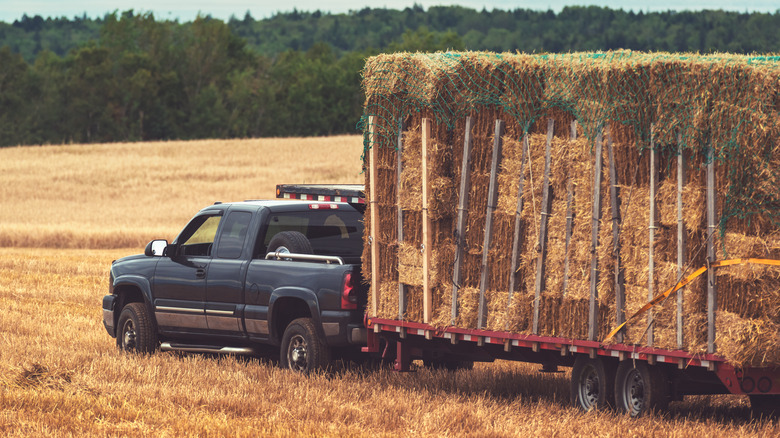How To Tell What Size Tool Box Will Fit Your Pickup Truck
There's a lot more to truck bed tool boxes than simply having a built-in place to store your tools — though that is their primary function. You need to think about cost, durability, and construction, as well as how exactly you plan to use it, how much weight it adds, who makes it, etc. Though arguably the most important consideration is the dimensions because your truck bed tool box won't be of much use if it doesn't actually fit in said truck bed properly. Fortunately all you really need to figure those measurements out is a tape measure.
As truck box manufacturer UWS points out, there are a lot of measurements that need to be taken to make sure the tool box you buy isn't too big to fit or too small to stay in place. Additionally, you might need to make additional checks if your pickup bed is a little more compact — otherwise those wheel wells could get in the way and you'll be left with a tool box you can't actually put in your truck.
Measure twice, buy once
Obviously you'll need to figure out the right dimensions, but the trick is knowing exactly what areas you'll need to measure.
- Start with measuring the bed frame rails ("exterior bed rail width"), which run from the one edge of the bed liner to the other, in the spot where you expect to keep the tool box. Typically this is right up along the back of the cab section.
- Now measure the inside of the bed rails ("interior bed rail width") by placing the tape measure up against the inside edge of the top of the bed liner, across to the other inside edge. Again, aim for the area you plan on installing the tool box.
- Put the tape measure against the back of the cab and measure backwards to 20 inches (average side depth), then mark the spot with a piece of tape or other indicator. From that marker, measure down to the bed for "vertical bed depth."
- If the wheel wells get in the way, note the distance between the top of the bed to the top of the well ("wheel well depth") and use that as your tool box depth instead.
If the bed is small enough that the wheel wells don't allow enough room, you can look into getting an angled tool box that tapers inward to allow for better clearance.
Measure more if you're towing stuff
There's a bit more you need to account for if you use (or plan to use) your pickup truck for towing with an in-bed hitch — either fifth wheel or gooseneck. If you don't plan on towing or expect to use a trailer hitch (mounts under the bumper) then you don't need to bother with this bit.
- Grab a straight edge that's long enough to sit across the top of the truck bed (a piece of wood also works, so long as the line is straight).
- If you're using a fifth-wheel hitch, place the straight edge so that it's lined up directly over two rail hitches that are closest to the back of the cab.
- If you're using a gooseneck hitch, line the straight edge up along the outermost edge of the gooseneck hitch that's closest to the back of the cab.
- Place the tape measure against the inside of the bed against the back of the cab (at the top of the bed) and measure back to the straight edge. This works for either (or both) your fifth wheel or gooseneck hitch measurements.
- Subtract your expected tool box side depth (20 inches is the average) from your hitch measurement to determine available clearance. As long as it's at least six inches of clearance, the tool box will fit just fine.
If you have less than six inches of clearance, look for a tool box with a narrower side depth.


